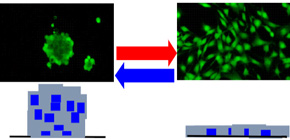
Monolayer/spheroid cell culture switching method using ureido polymer solution developed
A group of researchers from The Institute of Scientific and Industrial Research, Osaka University; the Graduate School of Bioscience and Biotechnology, Tokyo Institute of Technology; and Institute for Materials Chemistry and Engineering, Kyushu University; developed a novel culture method using polymer molecules which allows for controlling the aggregation state in the cell culture medium between a cell monolayer and a three-dimensional (3D) cell aggregate, a world first.
Culture cells are important medical resources in regenerative medicine approaches. A technique to cultivate cells, fabricate their 3D scaffolds, and design their forms is very important in growing tissues and organs, which are made of cells, in the lab.
Meanwhile, two-dimensional (2D) plane culture performed by using culture dishes and 3D spheroid culture using suspension culture are often used in conventional cell culture techniques; however, techniques to switch these states of cell culture have not been developed.
This group previously developed polymers with ureido groups and clarified that these polymers were unique in that they dissolve by heating under conditions of physiological pH and salt concentrations and become insoluble by cooling. This time, the group succeeded in spheroid/monolayer cell culture switching by the addition of ureido polymers to the cell culture medium and by controlling culture temperature.
Ureido polymers dissolved in the culture medium at culture temperature 37°C and culture cells maintained normal state of monolayer cell culture; however, upon cooling to 25°C, ureido polymers became the coacervate state, converting the monolayer cell culture to spheroidal form. Upon heating again to 37°C, spheroids returned to the monolayer cell culture. In this way, it was demonstrated that this method permitted reversible control of the form and function of culture cells.
This technique has permitted conversion of cells in monolayer culture to spheroids. It is hoped that this technique will be introduced to the field of regenerative medicine as an unprecedented method of controlling cellular aggregates (spheroids), a method in which one makes cells grow into spheroids and timely leads them into 2D layered tissues.
Abstract
Multicellular spheroids have been studied in the fields of oncology, stem cell biology, and tissue engineering. In this study, we found a new polymer material for thermo-controlled spheroid/monolayer cell culture switching. The polymers that have pendant ureido groups (ureido polymers) exhibited upper critical solution temperature-type phase separation behavior. Cells in monolayer culture were converted to spheroids by the addition of ureido polymers below phase separation temperature (T p ). Time-lapse observations indicated that cells began to migrate and aggregate to form the spheroids to avoid contact with phase-separated polymer (coacervates) on the surface of the culture dish. We supposed that the coacervates seemingly suppressed interaction between cell and the dish surface or extracellular matrices. By increasing culture temperature above T p , the spheroids began to collapse into a monolayer of cells due to dissolution of the coacervates. These results indicated that cell morphology could be repeatedly switched by changing the culture temperature in the presence of ureido polymers.
Figure 1
Figure 2
To learn more about this research, please view the full research report entitled " Reversible monolayer/spheroid cell culture switching by UCST-type thermoresponsive ureido polymers " at this page of the ACS Applied Materials Interfaces website.
Related link
